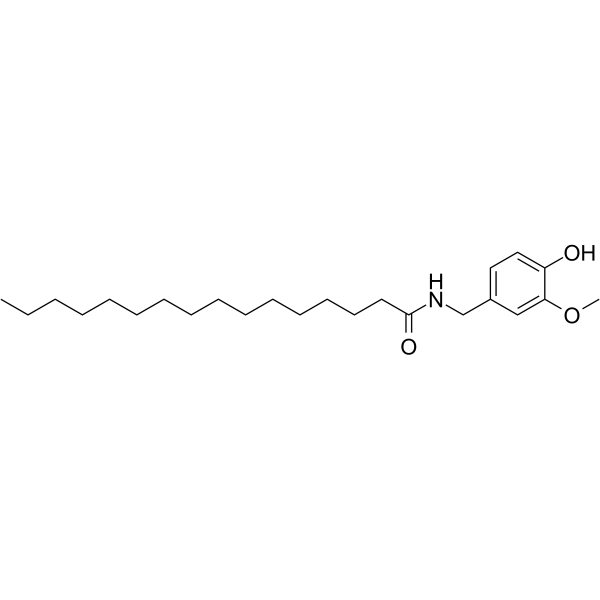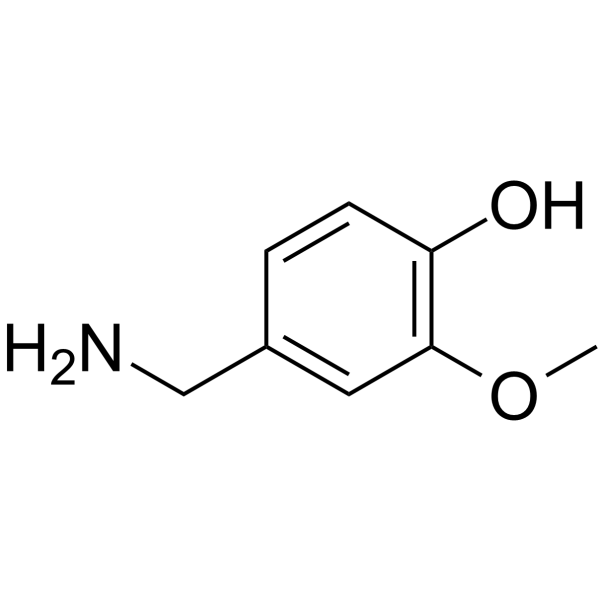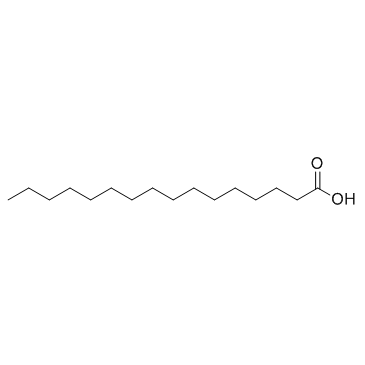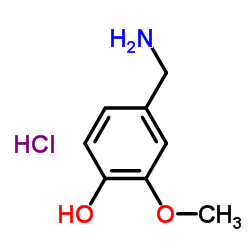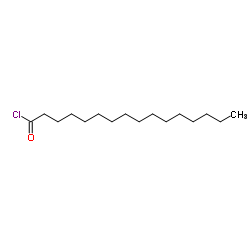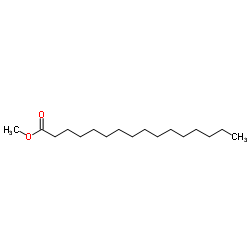69693-13-6
| Name | N-[(4-hydroxy-3-methoxyphenyl)methyl]hexadecanamide |
|---|---|
| Synonyms |
N-vanillyl-palmitamide
N-Vanillyl-palmitinamid N-vanillyl-hexadecanamide Palvanil |
| Description | Palvanil is a capsaicin analogue, shows strong desensitizing capability against the TRPV1 receptor. Palvanil shows anti-nociceptive and anti-inflammation effects[1][2]. |
|---|---|
| Related Catalog | |
| In Vitro | Palvanil (0.1-1000 nM; 0-300 min) leads to calcium increasment in intracellular[1]. Cell Viability Assay[1] Cell Line: HEK-293 cells Concentration: 0.1, 0.5, 1, 5, 10, 50, 100 and 1000 nM Incubation Time: 0-300 min Result: Produced a dose-dependent increase in intracellular calcium with a EC50 of 0.65 nM. |
| In Vivo | Palvanil (Subcutaneous injection; 1 or 10 mg/kg; once) treatment shows hypothermic effect[2]. Palvanil (Intraperitoneal injection; 100 μL (15 nM) per mouse; once) treatment reduces capsaicin-induced bronchoconstriction[2]. Palvanil (Intravenous injection; 0.5, 0.75, and 1 mg/kg; once) treatment shows antinociceptive effects on formalin-induced nocifensive behavior[2]. Palvanil (Intravenous injection; 0.5, 0.75, and 1 mg/kg; once) treatment inhibits carrageenan-induced inflammation[2]. Palvanil (Intravenous injection; 0.5 and 1 mg/kg; once daily; 7 days) reduces mechanical allodynia and thermal hyperalgesia in SNI mice[2]. Animal Model: Male CD-1 mice[2] Dosage: 1 or 10 mg/kg Administration: Subcutaneous injection; 1 or 10 mg/kg; once Result: Led to a slight and short lasting hypothermic effect, produced late hyperthermia. Animal Model: Female BALB/C mice[2] Dosage: 100 μL (15 nM) per mouse Administration: Intraperitoneal injection; 100 μL (15 nM) per mouse; once Result: Induced a significantly lower bronchoconstriction (from 0.47 to 0.605 cm H2O/L/s). Animal Model: Male CD-1 mice received formalin[2] Dosage: 0.5, 0.75, and 1 mg/kg Administration: Intravenous injection; 0.5, 0.75, and 1 mg/kg; once Result: Reduced the second phase of formalin-induced nociceptive behaviour in a dose-dependent manner. Animal Model: Male C57BL/6J mice with acute inflammation induced by carrageenan[2] Dosage: 2.5 mg/kg Administration: Intravenous injection; 2.5 mg/kg; once Result: Reduced the volume of the oedema in the ipsilateral hind paw (64%). Animal Model: Male CD-1 mice[2] Dosage: 0.5 and 1 mg/kg Administration: Intravenous injection; 0.5 and 1 mg/kg; once daily; 7 days Result: Reduced mechanical allodynia and thermal hyperalgesia at 3 and 7 days after nerve injury in a dose-dependent manner. |
| References |
| Molecular Formula | C24H41NO3 |
|---|---|
| Molecular Weight | 391.58700 |
| Exact Mass | 391.30900 |
| PSA | 62.05000 |
| LogP | 7.33860 |
| Precursor 8 | |
|---|---|
| DownStream 0 | |
